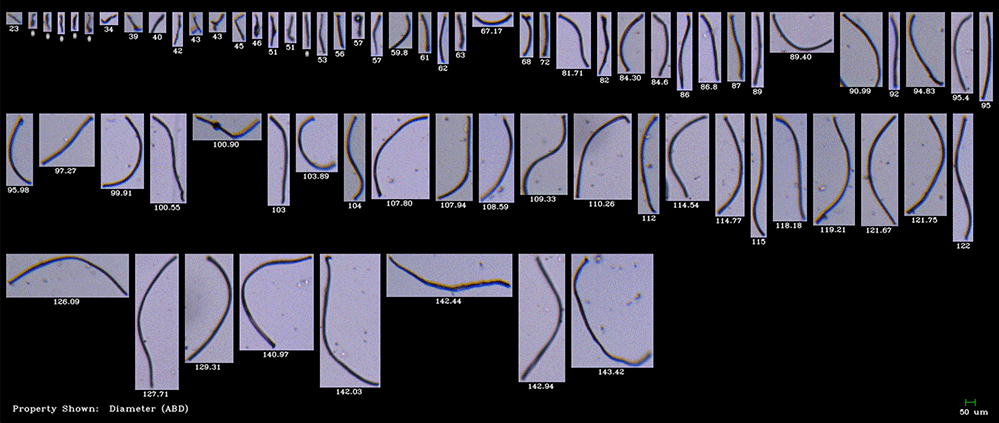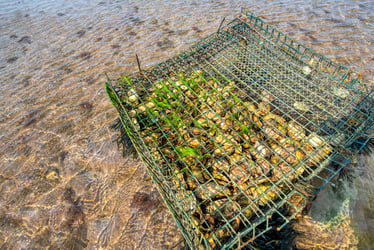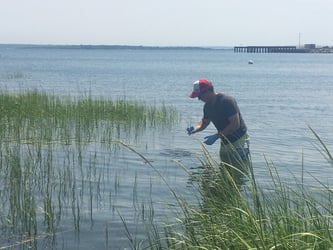Microplastics are a ubiquitous concern for the world's oceans. Increasing demand for consumer plastics has resulted in an estimated 4.8 to 15.11 million metric tons of plastics entering the oceans every year1,2. These macroplastics degrade into microplastics, or plastic fragments <5 mm in diameter, ranging in morphology from rigid pieces to amorphous fibers.
Pictured above: Microplastic fibers imaged by the FlowCam. Photo: Woods et al., 2018
It is currently believed that there are an estimated 1,000 to 1,000,000 microplastics per cubic meter of ocean water3,4, and about 91% of all plastics in ocean water are specifically microplastic fibers5. Microplastic fibers are sourced from synthetic clothing and are released into the environment through the disposal of waste and laundry wash water.
Bivalves are filter feeders that retain environmental contaminants, including microplastics. Due to their sessile nature, they are often used as indicators of local environmental contamination. However, most studies of microplastic uptake by bivalves have not utilized a realistic ratio or percentage of microplastic fibers6.
A recent study by Woods et al. observed how the Mytilus edulis, or the blue mussel, interacts with microplastic fibers at concentrations representative of coastal waters (3 to 30 particles per mL). FlowCam imaging flow cytometer was used to identify and enumerate microplastic fibers.6
Woods et al. found that filtration rates were significantly reduced in mussels exposed to microplastic fibers. Most microplastic fibers were rejected (71%) as pseudofeces, approximately 9% were ingested, and <1% was excreted as feces6. While mussels uptake microplastic fibers, they quickly reject the majority as "unsuitable" particles, preventing most from being ingested.
Access the abstract and full article here to read more about the methodology and implications of these findings. Also, read the blog post by Bigelow Lab on this research with quotes from the Bigelow scientists themselves.
At the 2018 Ocean Sciences Meeting, we presented Woods et al.'s methodology and preliminary findings alongside a digestive microplastic methodology from the Alfred Wegener Institute. Download the poster below.
Citations:
1 Jambeck, J.R., Geyer, R., Wilcox, C., Siegler, T.R., Perryman, M., Andrady, A., Narayan,
R., Lavendar-Law, K., 2015. Plastic waste inputs from land into the ocean. Science
347 (6223), 768–771
2 Lebreton, L.C.M., van der Zwet, J., Damsteeg, J.-W., Slat, B., Andrady, A., Reisser, J.,
2017. River plastic emissions to the world's oceans. Nat. Commun. 8, 15611
3 Noren, F., 2007. Small Plastic Particles in Coastal Swedish Waters. KIMO Sweden.
4 Andrady, A.L., 2017. The plastic in microplastics: a review. Mar. Pollut. Bull. 119, 12–22
5 Barrows, A.P.W., Cathey, S.E., Petersen, C.W., 2018. Marine environment microfiber
contamination: global patterns and the diversity of microparticle origins. Environ.
Pollut. 237, 275–284.
6 Woods, M.N., Stack, M.E., Fields, D.M., Shaw, S.D., Matrai, P.A., 2018. Microplastic fiber uptake, ingestion, and egestion rates in the blue mussel (Mytilus edulis). Mar. Pollut. Bull. 137, 638-645.











